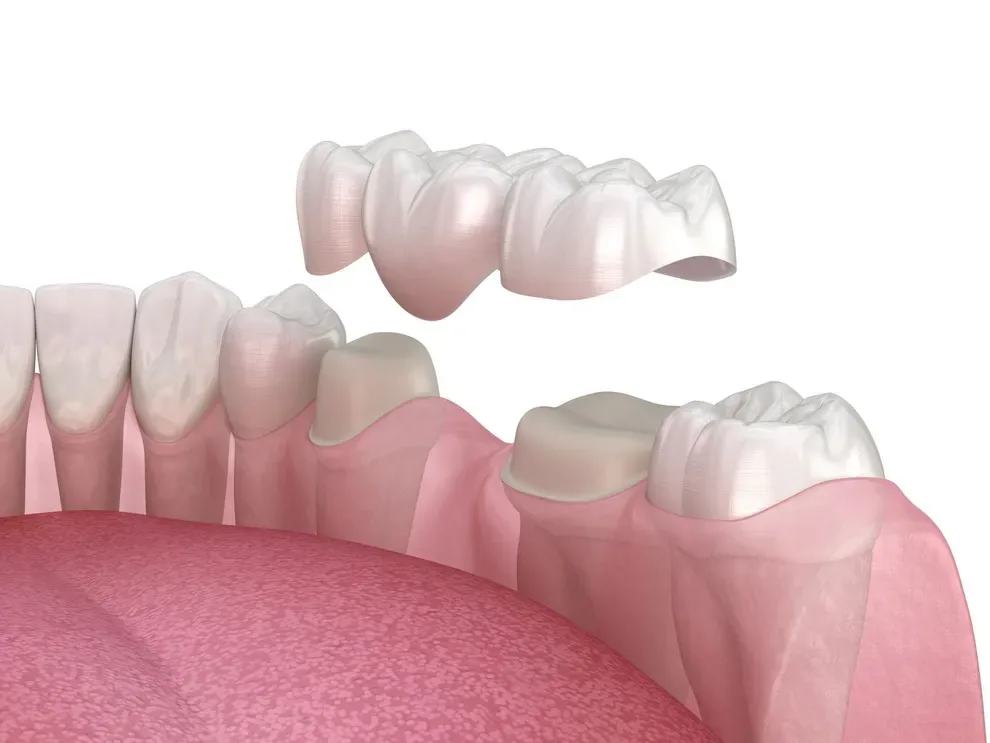How Much Do Dental Bridges Cost and Why Insurance Helps

Table of Contents
- How Much Do Dental Bridges Cost
- Will You Incur Costs After the Procedure
- Will Insurance Help
- Without Insurance
- References
If you’re missing any teeth, your dentist might recommend a dental bridge as a temporary or long-term solution. A dental bridge comprises a false tooth (pontic) attached to one or two of the teeth next to it.
These teeth (abutment teeth) provide the anchor points for the bridge. Alternatively, an oral surgeon can implant artificial abutments to provide anchorage.
Depending on the type of dental bridge you need and healthcare costs in your state, the cost of a dental bridge can run deep into the thousands. However, with insurance, you can get up to half of your dental fees paid off.
How Much Do Dental Bridges Cost?
You can get a dental bridge procedure done for between $1,500 and $15,000 depending on four things: the type of bridge you need; how many missing teeth you have; the difficulty of the surgery; and where you live.
There are four types of dental bridges:
Cantilever
Traditional
Maryland
Implant-supported
A traditional dental bridge is the best option when the gap is between two teeth. These are first filed down, then artificial crowns attached to the pontic are cemented onto them. A cantilever dental bridge only requires one natural tooth next to the gap. It becomes the abutment tooth from which the false tooth or teeth are suspended from across the gap.
A Maryland dental bridge is similar to the traditional ones, but instead of cement, it bounds the pontic to the back of the abutment teeth using a framework of metal or porcelain.
Implant-supported bridges use surgically installed abutments instead of natural teeth. Usually, an oral surgeon inserts titanium posts into the gum to serve as the pontic(s) abutments. This procedure may require bone grafts and is only viable if you have sufficient bone density. It is the most permanent type of dental bridge.
The number of pontics needed will heavily influence the total cost of the procedure. Similarly, if you have gaps that are separated by teeth, you will require individual bridges for each. That might make the procedure more expensive.
The less accessible the gap is, the harder the procedure becomes. The harder it is, the more costly it is. In addition, dental problems like periodontal disease can cause complications, so they must be treated before the procedure, which will incur extra costs.
If your state has higher healthcare costs, it may affect how much you pay for a dental bridge. Some states have seen a steady rise in healthcare costs over the last five years, with Houston’s rising by 14 % as of 2020. This trend makes insurance coverage more important for dental bridges, which are typically not classified as a preventative treatment.
Possessing good bone density is crucial to support implant-supported bridges, and for patients lacking in this area, a bone graft may be taken.
Breakdown of Costs: Will You Incur Costs After the Procedure?
Traditional bridges use two anchor points, whereas cantilever bridges only need one, even for multiple false teeth. The cost per pontic with its abutment crown(s) ranges from $2,000 to $5,000 without insurance.
A Maryland dental bridge includes the “wings” attached to the abutment teeth and the pontic itself. The cost of one pontic with its abutment framework ranges from $1,500 to $2,500, making it slightly cheaper than the traditional bridge.
The cost of two titanium dental implants spanning three or four teeth ranges from $5,000 to $15,000.
A dentist can install traditional, cantilever, and Maryland bridges in two sessions, but implant-supported bridges may require three or more to complete. You will need a five to six-month period to recover from the surgical incisions before permanent teeth are cemented onto the titanium abutments. In the meantime, your dentist will install removable dentures.
Your dentist may also prescribe pain medication after the procedure. Monthly follow-up sessions will prolong the lifespan of the dental bridge. Most of this will be covered by insurance, so having coverage can be helpful.
Will Insurance Help?
You will pay significantly less for a dental bridge with insurance coverage. However, it’s important to be familiar with your provider’s policies as they vary considerably between providers. Some things to look out for are:
Exclusions for pre-existing conditions (such as periodontal disease)
Waiting periods for healthcare that’s not preventative
The former can make you ineligible for insurance coverage for dental bridges, while the latter will require you to wait at least one year to get coverage for any procedures outside of preventative care.
Dental insurance covers 40% to 50% of the total cost of dental bridges. Of course, the percentage covered varies by provider and geographical location. Nevertheless, this is the most common range offered by insurance companies.
Without Insurance
Insurance will reduce your dental bill by around half and will cover the cost of aftercare necessities such as pain medication, follow-up visits, and more.
Keep in mind that all of these procedures require two sessions or more to complete, and most healthcare providers will bill you for each of them. The surgical option will require two or more x-rays to establish bone density and to ascertain that the implant has settled.
You may also need to replace a failed bridge years down the line as dental bridges sometimes come apart. The dental costs it could run you are significant, especially if you’re paying them in full.
Insurance dramatically cuts down the cost of getting the best dental service in your area and receiving quality dental bridges that last for years.
